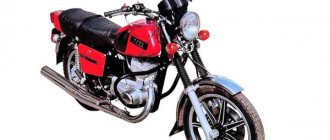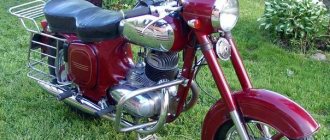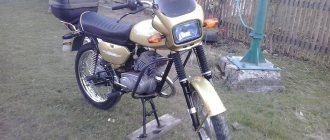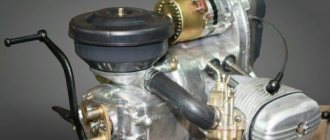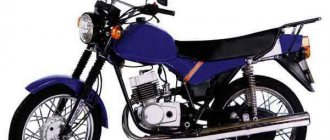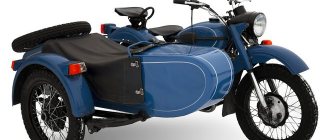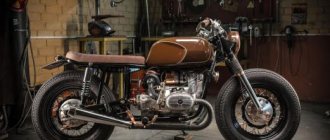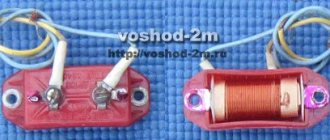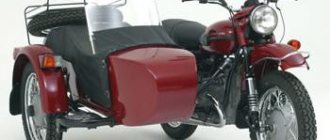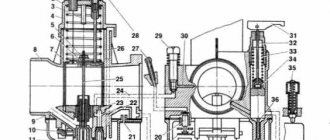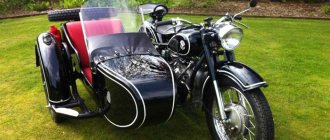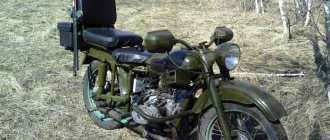The legendary Java 350 motorcycle is the dream of every motorcyclist of the late 20th century. Not a single Soviet motorcycle could compare with the quality of workmanship and smooth running of the Java. The particular popularity of Czechoslovakian technology is still relevant today. Naturally, every owner wants to improve the characteristics of the model, and the topic of today's article is Java tuning. In it we will look at what Java 638 tuning is, how to achieve better performance from the engine and create a modern appearance with your own hands. Let's find out how the Java 634 tuning differs from the 638 model and which is better.
Tuning Java 350 let's start with the engine. Clean the engine thoroughly from dust and oil to prevent dirt from getting into the engine. Having completely disassembled the engine, carry out a complete inspection for wear. It is recommended to immediately replace the bearings with new Japanese ones, since only they can cope with the increased speed and increased power when tuning the engine. Keep in mind that boosting the motor is a serious matter; at least turning, a grinding tool, and preferably a drill to change the purge channels will be required. The factory shape of the channels provides traction at low and medium speeds, which is done in order to save fuel. By slightly boring the cylinder bores a few millimeters in height, you can increase the engine speed and, accordingly, its power. To improve purging, be sure to align the channels of the lower plane of the cylinder with the upper plane of the crankcase; steps and protrusions that will interfere with the flow are not allowed. Also sand down any irregularities in the intake and exhaust ports until they are smooth. Then we move on to tuning Java 638 cylinder heads. To do this, having secured the heads in a lathe using a mandrel, cut them with a cutter by 1.5-2 mm, due to which the combustion chambers will decrease and the compression ratio will increase. If you have a Java 634, tuning the pistons consists of making them lighter; to do this, the jumpers of the lower piston skirt are cut off, and the free space under the piston will ensure the unhindered flow of the fuel mixture. Tuning Java 638 is more preferable because it has aluminum cylinders that can withstand boost much better and effectively remove heat.
The power supply system is very important for a two-stroke motorcycle. The filling of the cylinders and power depend on the quality of mixing of fuel with air. Reed valves also play a huge role in this system. It allows the fuel mixture to be admitted when the piston is sucked in, and does not allow the mixture to be pushed back, thereby improving engine performance. Reed valves can be selected from any other two-stroke motorcycle of similar capacity. A photo example is shown below:
The efficiency of tuning Java 638 can be significantly increased by dividing the intake channels into two separate ones for each cylinder with its own carburetor.
One standard carburetor is not able to fully cope with its task and significantly chokes the engine in terms of speed. Installing crossover carburetors from Mikuni or Keihin with a diffuser size of 28mm will radically change the behavior of the engine. You can read how to set up a Java carburetor here.
Bright, stylish, but still Dnepr
Looking at this motorcycle, different emotions immediately appear in me. On the one hand, the author of the project had a hand and spent a lot of time creating this “horse”, but on the other hand, I don’t see much point in them. It is unlikely that this homemade seat will be more comfortable than the standard one.
Exhaust
- the highlight of the whole design. As for me, the “cans” are too massive for the pipes that go directly to the cylinders. I think if they were made thicker in cross-section, this modification would look somewhat more impressive.
The colors here are extremely bright and dull
, but this is
a matter of taste
. And, according to the classics of the genre, we are witnessing the abandonment of the steering wheel and the fact that the author of the project gave preference to clip-ons, completely cutting down the ability to move around on this motorcycle.
Refinement and tuning
Since the new Java 638 is very popular and the demand for this motorcycle does not subside, craftsmen continue to refine both the appearance of the motorcycle and its characteristics. On the Internet you can find many reviews and interesting technical solutions for tuning this motorcycle.
The change in appearance is sometimes so dramatic that it is difficult to believe that this motorcycle was once a classic java. The wheel rims are replaced with cast light alloy ones, the old front steering wheel fork is replaced with a more advanced, longer one, the seats and headlight are changed. There are simply no limits to the imagination of inventors.
To improve driving characteristics, drum brakes are replaced with higher quality disc brakes. To increase the service life of the engine, the bearing seats are changed, thereby improving their lubrication.
Previous entry Java 350 - parameters and special properties of the legend Next entry Technical characteristics of the Planet Izh 4 motorcycle
Java engine tuning
First of all, I would like to talk about modernizing the engine of this once legendary bike.
The latter is done quite easily and quickly these days. The method of strengthening the power unit, given to us by our parents, will remain virtually unchanged. These motorcycles are quite easy to boost. Tuning Java often involves adding another carburetor to the engine. In this case, the mounting of the basic fuel regulator is subject to change. A carburetor is installed on each cylinder only after a new mount (adapter) is installed on each “pot”. All this is mounted on pins - there is no need to invent anything new, as you can see for yourself. Each carburetor needs a separate filter. Buying a faucet for a tank with a couple of outlets is also not difficult.
Firstly, you need to adjust the purge channels for tuning the Java 350. In addition, the main goal of upgrading the Java engine is to increase the compression ratio. This way you can certainly supplement the power of the bike. All this won't cost that much. If you do not have the necessary tools and equipment for speeding up, you can turn to a turner. Even in small towns, such specialists are present, for which we must thank, first of all, the Soviet government, which relied on the engineering and mechanical potential of the labor resources of the USSR. There are many machines left on post-Soviet soil that are quite suitable for reducing the combustion chamber.
Do not forget that any changes to the combustion chamber, as well as the cylinder windows, must be carried out with the utmost care. Any mistake, in this case, can render the rather fragile duralumin “pots” unusable once and for all.
You will probably find photos of bikes after some of the above modifications here too.
Repair and tuning
All Soviet-era equipment, even imported, is distinguished by its simplicity of design. This is both good and bad. Maintainability in this case goes hand in hand with outdated technologies, which these days are not used even by Chinese and Indian motorcycle manufacturers specializing in extremely low-cost equipment.
Repair
Who will drag Java 350 to the service? Such motorcycles are repaired in the garage, with love and strong words when something doesn’t work out. But seriously, even an inexperienced motorcyclist can understand the design of a Czechoslovakian bike, because it is extremely simple. The wear resistance of some components is low, but they are very easy to repair or replace.
Spare parts
It is very difficult to find original spare parts for a model that was discontinued a long time ago, and you only need to look for it on message boards, owner forums, and so on. They are almost never sold in stores, although there are Chinese analogues of unknown quality. However, they are still not suitable for restoring a motorcycle to its original condition.
Tuning
In the past, this bike was often tuned, especially in rural areas, but now it seems blasphemous. Such motorcycle equipment, which has survived to this day, needs to be carefully restored, and not turned into a traveling exhibit of the “Collective Farm Tuning of the Year” exhibition. And those who do not agree with this, and intend to turn an old Java into a “chopper type” or “sportbike type” with the help of an angle grinder and a sledgehammer, need to be beaten for a long time and thoughtfully with an adjustable wrench until they realize the fallacy of their intentions.
General concepts of Java tuning
Improving Czechoslovakian Jawa quite often involves the installation of new electronics.
In addition to the ignition system, the number of lighting devices also changes. Fog lights are installed, new indicator lights are installed on the panel, the sound signal is replaced, etc. However, the instrument panel is often left unchanged by tuning specialists for the 634 Java. This legendary Czech motorcycle already has everything that is needed to indicate the operation of the bike. The most pleasing thing is the presence of a tachometer. Sometimes the front end of the above iron horse becomes heavier. Since a motorcycle can easily rear up (on a goat), this often infuriates many motorcycle enthusiasts. Tuning Java, in this case, makes the front structural elements heavier in any way the owner likes.
What can be tuned in Dnepr?
At the time these motorcycles were released, their quality was at the highest level, so all the components and the design itself still actively serve all owners. But modern requirements for appearance and some technical characteristics force us to carry out cosmetic and internal modifications to the motorcycle. Of course, you can do the tuning of the Dnieper with your own hands, but if you don’t have enough knowledge, workshops are open in most cities where people are probably knowledgeable in modernizing Soviet motorcycles.
There are basic elements that need to be changed when tuning, and in this model the following elements can be improved or even replaced:
You can also briefly discuss the refinement of each element. For example, to tune the exhaust system, you will need to install a forward flow system and nickel elbows, which you can do yourself. External tuning will contain a lot of chrome parts, so tuning the Dnepr engine will involve a polishing process. If you upgrade these two parts, your motorcycle will not only look great, but it will also sound great.
As for technical modernization, the above recommendations can be supplemented by installing a fifth gear on the Dnepr. It is unlikely that you will be able to do this kind of work yourself, so it is better to turn to specialists with experience. But the result will be justified; your vehicle will have reverse gear. But even this is not where the basic tuning ends, because some Dnepr models, depending on the year of manufacture, can be improved by installing an electric starter.
Java in the 21st century: is it easy to own a legend?
Greetings, friends!
Many people remember JAWA motorcycles from Soviet times as a very reliable, trouble-free motorcycle with excellent driving characteristics.
But is this true today?
Java 638-5-00, 1985
Java 638-5-00, 1985
After all, over more than 30 years, a lot has changed dramatically both on the roads and in our lives in general.
Well, using the example of my Java specifically, I will try to tell you what Yavists have to face in our time.
Body and frame tuning
Its appearance will largely depend on how the frame base on the motorcycle is redone. At the present stage, there are several popular ways to remake the Dnepr frame.
Regardless of the modification of this bike, all models have a similar frame design.
You can extend the frame at the rear of the motorcycle. This tuning involves adding 15-20 centimeters to the frame, which increases the space for the rider’s legs. When the frame is lengthened, the driveshaft also lengthens, and the adjustment of the distance by which the frame should be lengthened depends on the height of the driver. If you lengthen the frame in the front part, you can achieve a landing similar to classic American choppers, while you do not need to change the driveshaft, but you will have to redo the pedal arrangement.
The frame is also expanded. We are talking about installing a more powerful rear wheel. To do this, an additional gearbox is installed on the cardan shaft, which will shift the cardan output to the side. It is best to install wheels with a profile of 130-150 millimeters, this way you can achieve optimal ride quality from the bike. A tire that is too wide can add certain difficulties to the driver.
When changing the angle of the front fork, experts recommend increasing the angle of inclination by no more than 35 degrees, otherwise the handling of the motorcycle will be seriously affected. In addition, an increase in the angle of inclination is accompanied by loads on the “stays” of the front fork, which leads to their rapid wear and failure.
Changing the angle of the rear shock absorbers will provide a more aesthetically pleasing appearance for the motorcycle, however, as with the front forks, too much angle can result in a loss of load-carrying capacity to the point where even single-passenger riding becomes impossible.
Repair and maintenance
The 12-volt generator of the 638 engine was considered one of the best of its time, and the engine generally corresponded to its time, reliable and lightweight. Although there are also disadvantages. The carburetor is very complex for such a simple motorcycle as the Java 350 638. The carburetor does not change the technical characteristics much. It has small jets that become clogged with the smallest particles. The main disadvantage is starting the engine. When the temperature drops deep into the minus, starting the engine turns into torture with shamanic dances and a tambourine. Gasoline has to be poured through the spark plug holes. Over time, starting problems appear in warm weather; cleaning and adjusting the carburetor does not bring much benefit. The instructions include advice to clamp the ventilation holes when starting the engine, but this does not bring any tangible benefit.
Naturally, over time this defect only becomes stronger. Some solve this issue by replacing the carburetor with a carburetor of a different system.
There is a problem with the lack of tires for Java on sale; they use tires from Izhevsk motorcycles for the Java 638 motorcycle. The technical characteristics of the tires are appropriate, except for the nipple for the camera, it is larger. You have to widen the hole in the wheel rim. With the development of motorcycle power, brakes improved more slowly and the Java has a problem with the rear brakes. When you suddenly try to stop, the brake cover turns out the reaction lever, the cable breaks, the wheels are blocked, then the movement is skidding and there is every chance of a coup and fall. This happens due to an oversight by the motorcyclist when the rear wheel axle nut is loosely tightened, but the design itself is flawed. There may simply not be enough threads on the axle.
It is also worth mentioning the steering lock, which can be pulled sharply to the left enough to break the clutch. The drive drum teeth wear out very quickly. Perhaps the reason is the quality of the metal.
Unusual yellow Java 638
Perhaps, such Java is truly the only one in the world!
Here I can definitely say that I would like this “tuning”
did not engage in training under any circumstances. I had enough sad experiences with vinyl film, but this is still on a completely different level.
I can’t say that this solution looks beautiful, nor can I imagine what will happen to all these “carpets” after a trip in the rain.
Extraordinary JAWA tuning in action!
I remember as a child I was perplexed when I saw motorcycles passing by, whose seats were covered with some kind of skin, carpet, fur coat or something like that. Is this really convenient?
What's wrong with standard casing? Even if it was in short supply, is it really impossible to use another, more suitable material?
Well, I’m generally silent about the fairing. The solution with lighting devices is strange, in my opinion. At the very least, very extraordinary. And yet it is not clear why he was wrapped in a rag. Probably to match the seat.
Walking abilities
There's nothing but good things to say here. Java confidently holds the track, the dirt is a little worse, but since she is a thoroughbred “road racer”, there is no point in getting into the mud with her.
Java copes well with long journeys; the long engine life allows you to travel many thousands of kilometers without breakdowns. And the “Southern” trunk allows you to take a decent amount of things, which is rare even for most modern motorcycles (without additional body kit).
In the city it feels as good as on the highway, the center of gravity of the motorcycle is high, because of this it handles well at low and medium speeds.
For driving on the highway, of course, you should come up with some kind of windshield, but I think this will not be a problem.
The motorcycle's consumption is low, about 4.5 l/100 km, a pretty good indicator
Improved technical characteristics
The following steps are allowed:
replacing standard crank (crankshaft) bearings with support units of better quality, attention, without reducing the size of the journals; installation of K-301B instead of the base carburetor, with mandatory adjustment of the synchronization of its operation; cleaning the engine cylinder channels and setting the ignition timing from 40 to 42 0; installation of a pair of air filters from GAZ-24 or Moskvich-412; minimizing the weight of connecting rods and pistons - an example is removing flash - to improve engine performance; organization of inertial boost - with it, the tuned Ural will be able to reach higher speeds, but only if a high-quality and reliable compressor is selected; production of a camshaft with cams of a non-standard profile, facilitating changes in valve timing; although it is better to entrust this task to professionals; making new gearbox gears is a more than justified measure, since standard parts usually make quite a lot of noise during operation, shift relatively poorly and do not last very long; alignment, grinding, lapping of both intake and exhaust valves - to increase the efficiency of filling the cylinders with fuel.
Advantages and disadvantages
The Java 350 needs to be compared with contemporary motorcycles, and not with models produced today. And for its era, this bike was, without exaggeration, magnificent! It was not for nothing that it was so popular in the USSR, despite the fact that Soviet motorcyclists had to order spare parts for it from the allied Czechoslovakia using various tricks.
Advantages
- Power. All sorts of “Voskhods” and “Izhi” could not compete with the Czechoslovak motorcycle on the road.
- Significant service life of the engine and CPG, noticeably longer than most Soviet bikes.
- Moderate mass, less than that of the Ural or Jupiter.
Flaws
- Difficulty finding spare parts these days. You can find everything, but you have to run.
- Compared to modern competitors, Java 634’s technical characteristics cannot stand any comparison even with the “Chinese”. The 638 model, however, does the same.
- It’s simply a pity to use the completed Java 350 as a vehicle for every day.
Addition
Tuning Java 350 very often affects the exhaust system. Despite contraindications from specialists, many owners install forward flow systems made from VAZ 2131 mufflers on this motorcycle; 21213; 21214. The part of the pipe leading to the engine is cut 5 cm from the muffler itself, and the part going out is bent at the required angle. When connecting to the elbow, the pipe is slightly cut and pressed tightly. The body mount is first welded to the forward flow, and a footrest is finally mounted on the motorcycle itself.
The tachometer, often borrowed from the VAZ 2106, will add to the presentation and functionality of the unit. Its connection is made according to the same parameters as in the car. Installing a starter on a Java 350 is a rather complicated procedure, but quite realistic. It requires a flywheel change, additional mounting on the body and a reinforced battery.
Motorcycle lighting is another characteristic manifestation of sports tuning. LEDs, the color of which can either emphasize the color of the device or be in contrast with it, illuminate key design components: the engine, exhaust pipe, rims.
Correctly performed tuning can not only transform your two-wheeled friend, but also significantly improve its technical parameters, making the motorcycle the envy of surrounding motorcyclists.
Motorcycle chassis
The frame of this model is universal and made of durable components and materials. This was necessary in order for the motorcycle to work well with maximum load capacity and the installed sidecar. The telescopic fork Java 350 634 is made in such a way as to ensure confident movement not only around the city, but also in difficult terrain. Therefore, hydraulic front shock absorbers and a wheel with steel coil springs were installed.
To ensure good stability of the motorcycle on slippery roads, it was decided to install a wide rear fork support. By the way, the pendulum-type fork holds the rear wheel perfectly, which ensures traction.
Improved appearance and safety
Think about safety first. Standard rims, and even more so drum brakes, are not able to cope with the increased power. It is recommended to install a good disc brake along with replacing spoked rims with alloy wheels. This will not only give a modern look to your bike, but will also significantly improve stability on the track. Accordingly, improved rims from another motorcycle are designed for greater braking force and have normal mounting for the brake disc. Good road tires are also a must.
Replacing headlights and other outdated lighting equipment will appeal to everyone. And the dashboard can be easily transformed by installing LED strip lighting.
The standard steering wheel can be easily replaced with clip-ons or a straight-shaped steering wheel, which will somewhat improve the driver’s aerodynamics due to the inclined seating position. Installing wind deflectors is no longer in fashion, as in Soviet times; they create too much air resistance in front of them. Much preferable is a sports body kit, which, depending on the financial investment, can be picked up from any other motorcycle, but if you really want to make it yourself from fiberglass and epoxy resin. Tuning a Java motorcycle in the photo:
And finally, we want to say that a forced engine requires good 2-stroke oil and timely maintenance. Java tuning is a fascinating activity that requires imagination and direct hands. If you follow the tuning technology, the result will not leave you indifferent
Java is a dream motorcycle of the 70-80s of the last century. IZH, Voskhod, Minsk, even the powerful Ural, all this is not the same in comparison with the only imported motorcycle widely available to the Soviet motorist - Java. And even though this is not a bike from the decaying, but technically more developed West, but an import from a country party to the Eastern Treaty, Czechoslovakia, at that time, was ahead of the USSR in the quality and technical perfection of the motorcycles produced. Java was perhaps the best thing that a Soviet person could acquire for himself back then, and the motorcycle deservedly became a real legend for several generations.
1970 The Java 350 model is entering the market. A powerful, maneuverable motorcycle with a load capacity of 200 kg, a two-stroke engine, disc brakes, and a fashionable and sporty appearance. Java is completely different from other models available on the market. Soviet motorcycles of that time were not far removed in their technical characteristics and appearance from the German models of the 40s, on the basis of which mass production of domestic motorcycles was launched using equipment exported from Germany. Owning a Java motorcycle was considered prestigious, fashionable, and simply a must for anyone who wanted to keep up with the times.
The history of the motorcycle
The history of the legendary Soviet motorcycle began back in 1934. Then the first model appeared - Jawa 350 SV. It was a bike with a single-cylinder engine producing 12 horsepower. Its maximum speed was 100 km/h, and it weighed 125 kg. On such an iron horse, Soviet racers won international competitions.
Due to the war, Jawa production was suspended until 1948, but the new Jawa 350 Type 12 did not stay on the assembly line for long. Serial production resumed again in 1954 with the release of Java 350 354/06. From this year, the motorcycle began to enjoy success in the countries of the USSR and took its place in the motorcycle market. The bike was equipped with a two-cylinder engine with a displacement of 350 cc. cm and an air cooling system. Power increased to 16 hp, and then to 18, when new carburetors began to be installed on the motorcycle.
The legend has been modified several times. In 1958, cone shock absorbers were replaced with piston ones. The appearance of Java at that time was considered progressive and even somewhat futuristic. By the way, it is worth remembering the famous monument to Viktor Tsoi - the famous musician sits on Java 354/06.
Features of electrical equipment
In many respects, the components and assemblies of the Czech motorcycle were similar to domestic products, but at the same time they differed:
In those years, Java motorcycles were in short supply, so they were often sold second-hand. And at the same time, the price remained quite high. New owners could immediately get behind the wheel and operate the equipment without any restrictions, because:
Repair instructions for Java motorcycles officially supplied to the USSR
However, the manufacturer constantly modernized its motorcycle models, and each time made changes to components and assemblies. In particular, in different years the following were supplied to the territory of the USSR:
Original wiring diagram for Java 12V model 638
Equipment 6W
For the first 8 years of deliveries from Czechoslovakia, JAWA motorcycles were equipped with equipment designed for a current of 6V.
Original color diagram of electrical equipment Java model 634
There are differences in the above diagram due to modification. In particular, the JAWA 634.8.00 model does not have:
Subsequent motorcycles had these electrical parts installed at the factory. And domestic craftsmen independently equipped their “iron horses” using a new scheme.
Differences in voltage were not an obstacle for owners, who often independently converted the motorcycle’s power supply from 6V to 12V. This required:
Equipment 12W
Later, the manufacturer recognized the promise of 12-volt equipment and began to equip its products with it. Thereby:
Original photo of the Model 640 wiring diagram in Czech
Features of 12 volt equipment include a bipolar turn relay, which has not previously been found on motorcycles. Its operation scheme is based on the principle of the difference in the current consumption of the control lamp (6W) and the direction indicator lamps (21W):
when turning on the right turn, “+” from the generator or battery enters the right turn circuit, passing through the terminals of the bipolar relay;
Motorcycle in the USSR
The USSR was the main importer of Java. Between 1963 and 1983 alone, 1.5 million motorcycles of various models were delivered to the Soviet Union.
The constant problem with purchasing spare parts was solved to some extent with the help of orders through Posyltorg.
The last Java model supplied to the USSR in the late 1980s and early 1990s was the Java 350-638. The first Java 638 appeared in 1984 and bore the index 5. It was similar to the model 634-7. The differences were a new engine, 12-volt electrics, and a new front fork. The front wing was painted red, and the rear wing was painted black. The 634th model had wings painted light gray. Also on the instrument cluster, the neutral light is green. The tachometer received a green scale (Economic).
In 1986, Java 350-638-00 appeared, for the characteristic shape of the rear part it was also called “Pencil”. It was also called “Banana” or “Squirrel” because of the rear spoiler. In 1989, Java 350-638 appeared with the index 1-03, which received the popular name “Lux”, “Super” and “Stub”. It was distinguished by longer exhaust pipes and, accordingly, a larger bending radius, which led to the effect of raised mufflers. The mufflers themselves became shorter in length (like the model 634) and received dents on the inside in the area where the shock absorbers were installed, and the upper mount of the rear shock absorbers on the frame changed. Also, stickers took the place of the metal nameplates located on the gas tank and side covers. In the same year, model 638-1-04 (Twin Sport) appeared, with different decals and Cezet shock absorbers.
From 1971 until the end of the 1980s, “ Friends of Java Meetings”
" They took place in various cities of the country, the first rally took place in Odessa, then there were Chisinau, Riga, Moscow, Baku, Tbilisi, Kharkov, Poltava and others. Owners of Java motorcycles from all over the country came to the rallies. Some rallies took place directly in Czechoslovakia, with the participation of Soviet motorcycle enthusiasts. Competitions were always held as part of the rallies. One of them gave impetus to the start of the USSR motorcycle trials championships.
What else can be improved?
Some owners improve the exhaust system of the Java motorcycle. Tuning, the photo of which is presented below, is performed by installing direct flows from the mufflers of VAZ cars. The pipe leading to the engine is cut fifty millimeters from the muffler itself, and the outer part is bent at a certain angle. To connect to the elbow, the pipe is cut and installed securely. First, body clamps are welded into the forward flow, and a kickstand is installed on the bike.
The tachometer taken from the VAZ-2106 adds additional aggressiveness and presentability to the two-wheeled unit. It is connected identically to the connection diagram in the car. To install a new starter on a Java, you will need to replace the flywheel, install an additional housing mount and a reinforced battery.
A good innovation would be to change the lighting of the motorcycle. You can choose LEDs to match the color of the unit or play with contrast. The lighting of the rims, exhaust pipe, engine and other main components of the device will look original.
Exhaust system improvement
Another significant thing in tuning the Java 350 is the exhaust system. Unlike a 4-stroke engine, in a 2-stroke engine the cylinder is filled by purging the cylinder. With a properly assembled resonator, a fresh fuel mixture effectively fills the cylinder, and due to the conicity of the resonator, the sound wave is reflected. Thus, part of the mixture does not fly out into the pipe, but returning to the cylinder gives up to 20% more power. You can weld such a resonator with your own hands from sheet steel 0.6-0.8 mm thick, and argon or semi-automatic welding is recommended. The exhaust pipe of the resonator can be made by shortening the standard one by increasing the cone according to the drawing:
According to the figure, the engine will have a sharp pickup and increase in power around 5000 rpm. The damping nozzle is not necessary and only performs a noise-absorbing function. As with tuning the Voskhod motorcycle, this resonator can be used in the same way.
The significant mass of the crankshaft has high inertia, which is done for smooth operation of the engine. By lightening it, you can achieve a sharp response to gas and improved acceleration dynamics. Keep in mind that with this modification of the engine, it is extremely reluctant to operate at idle and low speeds. And of course, don’t forget about replacing the ignition from a contact system to an electronic microprocessor system.
Read more: Tuning Solaris 2021 photo
Jawa 350/639 (1991)
In 1991, Jawa released the 350/639. It was a mid-size naked bike, equipped with a 2-stroke engine with two cylinders. The engine was cooled by air. The engine displacement was 344 cubic meters. cm. The cylinder diameter was 58 mm, and the piston stroke was 65 mm. The engine was started using a kickstarter. The carburetor was responsible for supplying fuel. The maximum torque was 32 Nm at 4750 rpm. The motorcycle had a 4-speed gearbox. The main drive to the rear wheel was carried out by a chain. The braking system of the model was represented by a disc brake on the front wheel and a drum brake on the rear. The volume of the fuel tank was 17 liters. The reserve was 2 liters. Fuel consumption was 4 liters per 100 km. The motorcycle had two stainless steel exhaust pipes. Exhaust toxicity was 92.8 CO2 g/km. The maximum speed to which this model was capable of accelerating was 130 km/h. The motorcycle was available in several color options: red, white and black.
Java tuning and modification of various parts of the motorcycle
Java motorcycle tuning with your own hands. What can be improved in the Java model. Increasing power and other characteristics of the motorcycle.
The legendary Java 350 motorcycle is the dream of every motorcyclist of the late 20th century. Not a single Soviet motorcycle could compare with the quality of workmanship and smooth running of the Java. The particular popularity of Czechoslovakian technology is still relevant today. Naturally, every owner wants to improve the characteristics of the model, and the topic of today's article is Java tuning. In it we will look at what Java 638 tuning is, how to achieve better performance from the engine and create a modern appearance with your own hands. Let's find out how the Java 634 tuning differs from the 638 model and which is better.
Tuning Java 350 let's start with the engine. Clean the engine thoroughly from dust and oil to prevent dirt from getting into the engine. Having completely disassembled the engine, carry out a complete inspection for wear. It is recommended to immediately replace the bearings with new Japanese ones, since only they can cope with the increased speed and increased power when tuning the engine. Keep in mind that boosting the motor is a serious matter; at least turning, a grinding tool, and preferably a drill to change the purge channels will be required. The factory shape of the channels provides traction at low and medium speeds, which is done in order to save fuel. By slightly boring the cylinder bores a few millimeters in height, you can increase the engine speed and, accordingly, its power. To improve purging, be sure to align the channels of the lower plane of the cylinder with the upper plane of the crankcase; steps and protrusions that will interfere with the flow are not allowed. Also sand down any irregularities in the intake and exhaust ports until they are smooth. Then we move on to tuning Java 638 cylinder heads. To do this, having secured the heads in a lathe using a mandrel, cut them with a cutter by 1.5-2 mm, due to which the combustion chambers will decrease and the compression ratio will increase. If you have a Java 634, tuning the pistons consists of making them lighter; to do this, the jumpers of the lower piston skirt are cut off, and the free space under the piston will ensure the unhindered flow of the fuel mixture. Tuning Java 638 is more preferable because it has aluminum cylinders that can withstand boost much better and effectively remove heat.
The power supply system is very important for a two-stroke motorcycle. The filling of the cylinders and power depend on the quality of mixing of fuel with air. Reed valves also play a huge role in this system. It allows the fuel mixture to be admitted when the piston is sucked in, and does not allow the mixture to be pushed back, thereby improving engine performance. Reed valves can be selected from any other two-stroke motorcycle of similar capacity. A photo example is shown below:
The efficiency of tuning Java 638 can be significantly increased by dividing the intake channels into two separate ones for each cylinder with its own carburetor.
One standard carburetor is not able to fully cope with its task and significantly chokes the engine in terms of speed. Installing crossover carburetors from Mikuni or Keihin with a diffuser size of 28mm will radically change the behavior of the engine. You can read how to set up a Java carburetor here.
Review Java 350 638
Current reviews of the Java 638 characterize the motorcycle as a true friend, which has a pleasant appearance, thoughtful details and, unfortunately, their absence on the market. The biggest disadvantage is the current shortage of parts for this model. There are more than enough motorcycle owners, but even finding Java 638 spare parts in an online store is sometimes difficult. Owners also consider spare parts too expensive.
Motor Java 359 638
Unlike other Java models, this new product had an important feature - the Java 638 cylinders were made of aluminum. Thanks to this innovation, the weight of the structure has been significantly reduced, and thanks to the aluminum fins, air cooling has become even better.
The manufacturer has placed great emphasis on the engine, so its characteristics are competitive even today. Unlike its predecessors, this vehicle has surpassed them in all respects in terms of engine performance. At a maximum speed of 5,500 rpm, it had a torque of 31.38 Nm. But having a 2-stroke system has its advantage - the engine has better distribution of exhaust gases, and the fuel mixture distribution system is now even simpler. Also, repairing a 4-stroke engine will be much more difficult. And most importantly, the maximum speed declared by the manufacturer was 120 km/h, but some owners talk about reaching 130 km/h.
Design Java 638
The most important change in the new product was the presence of a front telescopic fork, which its predecessors did not have. Thanks to this, the Java 638 fork allows you to withstand driving both on a flat track and on a road with difficult surfaces. The general appearance of the motorcycle was quite popular at that time - the absence of plastic, a long and voluminous muffler and the ability to reach any part. The seat on the Java 638 was quite comfortable, you could take one passenger.
The manufacturer also took care to change the location of the fuel tank, which, with a volume of 17 liters, received a special fastening. Thus, when driving fast, almost no vibration is heard from the tank.
